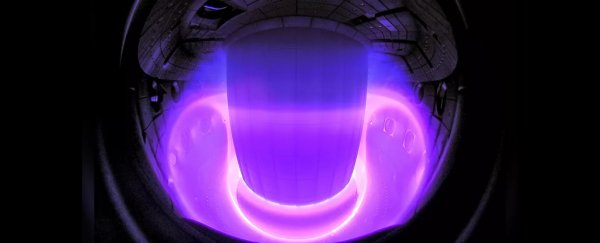Future fusion reactions inside tokamaks could produce much more energy than previously thought, thanks to groundbreaking new research that found a foundational law for such reactors was wrong.
The research, led by physicists from the Swiss Plasma Center at École Polytechnique Fédérale de Lausanne (EFPL), has determined that the maximum hydrogen fuel density is about twice the "Greenwald Limit" – an estimate derived from experiments more than 30 years ago.
The discovery that fusion reactors can actually work with hydrogen plasma densities that are much higher than the Greenwald Limit they are built for will influence the operation of the massive ITER tokamak being built in southern France, and greatly affect the designs of ITER's successors, called the Demonstration power plant (DEMO) fusion reactors, said physicist Paolo Ricci at the Swiss Plasma Center.
"The exact value depends on the power," Ricci told Live Science. "But as a rough estimate, the increase is on the order of a factor of two in ITER."
Ricci is one of the leaders on the research project, which combined theoretical work with the results of about a year of experiments at three different fusion reactors across Europe – EPFL's Tokamak à Configuration Variable (TCV), the Joint European Torus (JET) at Culham in the United Kingdom, and the Axially Symmetric Divertor Experiment (ASDEX) Upgrade tokamak at the Max Planck Institute for Plasma Physics at Garching in Germany.
He's also one of the lead authors of a study about the discovery published May 6 in the journal Physical Review Letters.
Future fusion
Donut-shaped tokamaks are the one of the most promising designs for nuclear fusion reactors that could one day be used to generate electricity for power grids.
Scientists have worked for more than 50 years to make controlled fusion a reality; unlike nuclear fission, which makes energy from smashing apart very large atomic nuclei, nuclear fusion could generate even more energy by joining very small nuclei together.
The fusion process creates much less radioactive waste than fission, and the neutron-rich hydrogen it uses for its fuel is comparatively easy to obtain.
The same process powers stars like the Sun, which is why controlled fusion is likened to a "star in a jar"; but because the very high pressure at the heart of a star isn't feasible on Earth, fusion reactions down here require temperatures hotter than the Sun to operate.
The temperature inside the TCV tokamak, for example, can be more than 216 million degrees Fahrenheit (120 million degrees Celsius) – almost 10 times the temperature of the fusion core of the Sun, which is about 27 million Fahrenheit (15 million Celsius).
Several fusion power projects are now at an advanced stage, and some researchers think the first tokamak to generate electricity for the grid could be working by 2030, Live Science previously reported.
More than 30 governments around the world are also funding the ITER tokamak ("Iter" means "the way" in Latin) which is due to produce its first experimental plasmas in 2025.
ITER, however, isn't designed to generate electricity; but tokamaks based on ITER that will, called DEMO reactors, are now being designed and could be working by 2051.
Plasma problems
At the heart of the new calculations is the Greenwald Limit, named after MIT physicist Martin Greenwald who determined the limit in 1988.
Researchers were trying to find out why their fusion plasmas effectively became uncontrollable (they expanded outside the magnetic fields they were contained by within the tokamak chamber) when they increased the fuel density past a certain point, and Greenwald derived an experimental limit based on a tokamak's minor radius (the size of the donut's inner circle) and the amount of electric current passing through the plasma.
Although scientists had long-suspected the Greenwald Limit could be improved upon, it has been a foundational rule of fusion research for more than 30 years, Ricci said. For example, it's a guiding principle of the ITER design.
The latest study, however, expands on both the experiments and theory that Greenwald used to derive his limit, resulting in a much higher fuel density limit that will both increase the capacity of ITER and impact the designs of the DEMO reactors that come after it, he said.
The key was the discovery that a plasma can sustain a greater fuel density as the power output of a fusion reaction increases, he said.
It's not yet possible to know how such a large increase in fuel density will affect the power output of tokamaks, Ricci said, but it's likely to be significant; and research shows greater fuel density will make fusion reactors easier to operate.
"It makes safe, sustainable fusion conditions easier to achieve," he said. "It allows you to get to the regime that you want, so that the fusion reactor can work properly."
This article was originally published by Live Science. Read the original article here.
